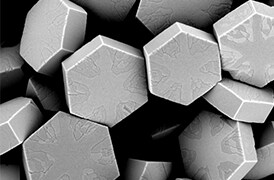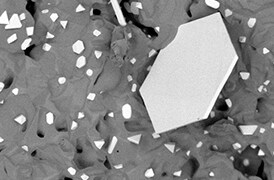Search

Materials Science
Electron Energy Loss Spectroscopy
High resolution electron energy loss spectroscopy for high signal-to-noise ratio elemental mapping and oxidation state probing.
Join the conversation
Electron Energy Loss Spectroscopy
Over the last three decades, electron energy loss spectroscopy (EELS) has become a formidable characterization technique. Used in combination with a transmission electron microscope (TEM), it can provide atomic-level chemical and structural characterization. This includes information about elemental composition, chemical bonding, oxidation states, valence and conduction band electronic properties, and surface properties. It can also be used in conjunction with other techniques, such as electron tomography, to provide advanced 3D mapping of elements and oxidation states.
As materials characterization becomes increasingly more demanding, there is a growing need for highly localized characterization of increasingly complex structures with ever smaller features. Fortunately, improvements in EELS and S/TEM instrumentation have kept pace with these demands, with advances including spherical aberration correction of the S/TEM lenses, as well as the use of monochromators to improve energy resolution, providing sub-angstrom spatial resolution and a higher probe current.
EELS TEM
With our X-FEG/Mono, X-FEG/UltiMono and X-CFEG guns on the Thermo Scientific Spectra and X-FEG on the Thermo Scientific Talos S/TEM platforms, Thermo Fisher Scientific has all your EELS applications covered. These systems allow you to perform ultra-high resolution EELS analysis to obtain valuable structural, elemental, and chemical information at the atomic scale.

Localized positions of plasmon excitations along a gold nanowire as a function of their excitation energy (between 0.18 – 1.2 eV), investigated with an electron probe of <0.2 eV energy resolution.

Localized positions of plasmon excitations along a gold nanowire as a function of their excitation energy (between 0.18 – 1.2 eV), investigated with an electron probe of <0.2 eV energy resolution.

Investigación sobre materiales fundamentales
Se investigan nuevos materiales a escalas cada vez más pequeñas para lograr el máximo control de sus propiedades físicas y químicas. La microscopía electrónica proporciona a los investigadores información clave sobre una amplia variedad de características materiales a escala nanométrica.

Control de calidad
El control y garantía de calidad son esenciales en la industria moderna. Ofrecemos una gama de herramientas de EM y espectroscopía para el análisis multiescala y multimodal de defectos, lo que le permite tomar decisiones fiables e informadas para el control y la mejora de procesos.

Investigación de baterías
El desarrollo de baterías se realiza mediante análisis multiescala con microCT, SEM y TEM, espectroscopía Raman, XPS y visualización y análisis 3D digital. Aprenda cómo este enfoque proporciona la información estructural y química necesaria para crear mejores baterías.

Investigación sobre polímeros
La microestructura polimérica determina las características y el rendimiento del material a granel. La microscopía electrónica permite un análisis exhaustivo en microescala de la morfología y composición de los polímeros para aplicaciones de control de calidad e I+D.

Investigación sobre metales
La producción eficaz de metales requiere un control preciso de las inclusiones y precipitados. Nuestras herramientas automatizadas pueden realizar varias tareas cruciales para el análisis de metales, incluyendo el recuento de nanopartículas, el análisis químico EDS y la preparación de muestras de TEM.

Fibras y filtros
El diámetro, la morfología y la densidad de las fibras sintéticas son parámetros clave que determinan la vida útil y la funcionalidad de un filtro. La microscopía electrónica de barrido (SEM) es la técnica ideal para investigar rápida y fácilmente estas características.

Estudios forenses
Los microrastros de las pruebas de las escenas del crimen se pueden analizar y comparar usando microscopía electrónica como parte de una investigación forense. Las muestras compatibles incluyen fragmentos de vidrio y pintura, marcas de herramientas, drogas, explosivos y residuos de armas de fuego.

Investigación geológica
Las ciencias geológicas están basadas en la observación uniforme y precisa de múltiples escalas de características dentro de las muestras de roca. SEM-EDS, combinado con software de automatización, permite el análisis directo a gran escala de la composición de la textura y los minerales para la investigación de la petrología y la mineralogía.

Investigación sobre catálisis
Los catalizadores son cruciales para la mayoría de los procesos industriales modernos. Su eficacia depende de la composición microscópica y la morfología de las partículas catalíticas; EM con EDS es ideal para estudiar estas propiedades.

Materiales 2D
La investigación de materiales novedosos presta cada vez más atención a la estructura de materiales de baja dimensión. La microscopía electrónica de transmisión de barrido con corrección de sonda y monocromación permite la adquisición de imágenes de materiales bidimensionales de alta resolución.

Pruebas de materiales para automóviles
Todos los componentes de un vehículo moderno están diseñados para garantizar la máxima seguridad, eficacia y rendimiento. La caracterización detallada de materiales de automoción con microscopía electrónica y espectroscopía informa sobre decisiones cruciales sobre procesos, mejoras de productos y nuevos materiales.
Servicios de microscopía electrónica para
la ciencia de materiales
Para garantizar un rendimiento óptimo del sistema, le proporcionamos acceso a una red de expertos de primer nivel en servicios de campo, asistencia técnica y piezas de repuesto certificadas.







